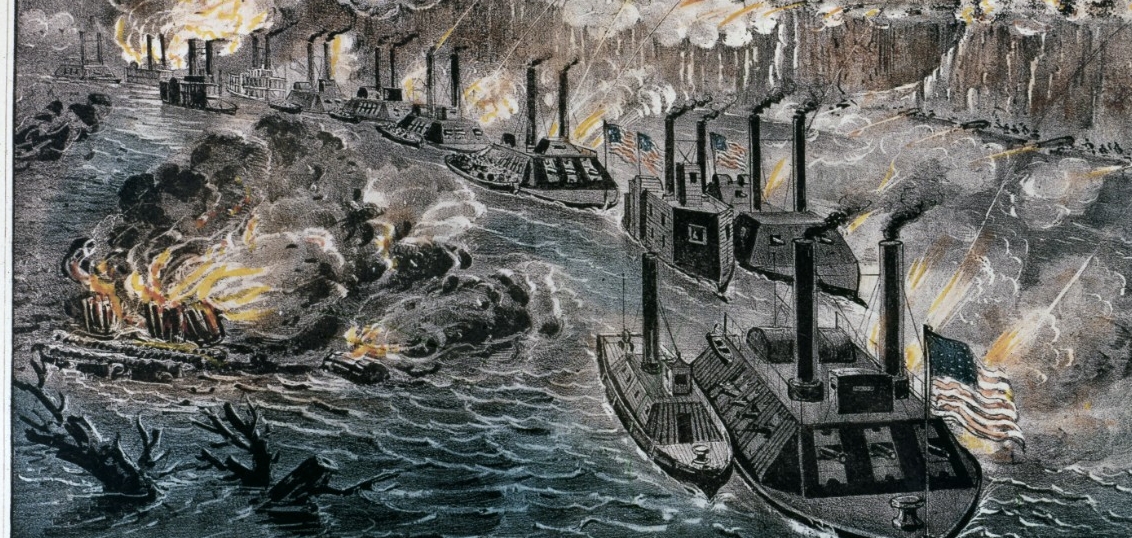Civil War Naval Operations and Engagements
1863
Note: This page is a work in progress. Please be patient as we continue to expand on the information available here. Look for the EXPLORE tab to see a full battle summary if available.
Galveston II
1 January 1863
On 1 January 1863, Major General John B. Magruder, C.S. Army, led his troops across the bridge into the island city of Galveston. At the same time, a makeshift fleet of “cotton-clads” confronted the U.S. Navy ships anchored in the harbor. Bales of cotton rather than iron protected each “cotton-clad” vessel. This coordinated attack caught Commander William B. Renshaw by surprise. After the destruction of Renshaw’s flagship, the Federal garrison on shore surrendered as the remaining Federal ships fled the harbor.
Fort Hindman
9–11 January 1863
Admiral David Porter, U.S. Navy, and his Mississippi Squadron ascended the White and Arkansas Rivers to attack the Confederate-held Fort Hindman on 9 January 1863. Over the next two days, Federal gunboats fired upon the fort as 32,000 soldiers under command of Major General John A. McClernand advanced toward the fort. On 11 January, Brigadier General Thomas J. Churchill, C.S. Army, and his garrison surrendered and became prisoners of war.
Charleston Harbor
7 April 1863
On 7 April 1863, Rear Admiral Samuel F. DuPont, U.S. Navy, attacked the fortifications at Charleston in response to pressure from Washington. The coastal artillery quickly repulsed the Federal ironclad fleet, and Major General P.G.T. Beauregard, C.S. Army, claimed an easy victory for the Confederacy. The land forces intended to support Du Pont’s fleet never disembarked from their transports. Du Pont quickly ordered a retreat, which ultimately led to his removal from his command shortly thereafter.
Vicksburg
18 May - 4 July 1863
In April 1863, Acting Rear Admiral David Dixon Porter, U.S. Navy, took a joint convoy past the city of Vicksburg. The convoy landed Major General Ulysses S. Grant, U.S. Army, and his troops below the city. Marching back toward Vicksburg, Grant’s troops clashed with Confederate soldiers before they laid siege to the city. Forty-seven days later, John B. Pemberton, C.S. Army, finally offered a conditional surrender. The cooperation between Porter and Grant in this campaign set a new precedent for joint operations.
Charleston Harbor II
6–8 September 1863
After 60 days under siege from combined U.S. forces, General P.G.T. Beauregard, C.S. Army, ordered his troops to abandon Morris Island in Charleston Harbor. On the night of 6–7 September, his troops withdrew from Fort Wagner and Battery Gregg. Rear Admiral John A. Dahlgren, U.S. Navy, quickly reiterated his demand for the surrender of Fort Sumter. When the enemy refused, Dahlgren ordered an ill-fated amphibious assault on the night of 8–9 September. Fort Sumter and the city of Charleston remained under the control of its Confederate defenders until 1865.
Sabine Pass II
8 September 1863
On 8 September 1863, Lieutenant Frederick Crocker, U.S. Navy, and General William B. Franklin, U.S. Army, attempted to launch an invasion of east Texas beginning with a joint assault of the fort at Sabine Pass. The Confederate garrison of Fort Griffin successfully defended the fort, and the U.S. joint forces were required to retreat to Louisiana and abandon their plans for this area of Texas.
Fort Brooke
16–18 October 1863
On a mission to destroy Confederate blockade-runners, Lieutenant Commander Alexander A. Semmes, U.S. Navy, fired on Fort Brooke near Tampa, Florida. His goal was to distract their garrison from the landing party at nearly Ballast Point. The U.S. Navy sailors traveled inland on foot and successfully destroyed Confederate vessels hidden 14 miles inland on the Hillsborough River before they retreated to their ships.



